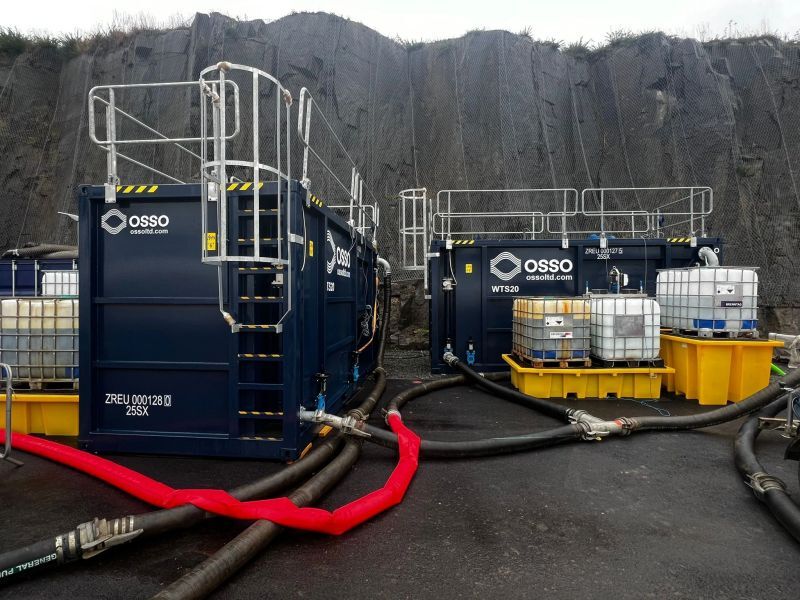BLOG
Water treatment in construction: Go clean to go green
19 NOVEMBER 2025
Greater scrutiny and accountability may be helping to drive an attitude change in the construction sector when it comes to onsite water management. But is it happening fast enough – and could automated solutions help to accelerate things? Tristan Hughes, Business Unit Manager outlines how new treatment alternatives might help companies avoid troubled waters, safeguarding their bottom line and their reputation…
Daily walks along river banks, canals, lakesides, beaches: they were a familiar routine for many of us during the long months of COVID-19 lockdowns. And I believe they gave us a greater appreciation of our local aquatic environment – a new sense of its value, and a fresh awareness of how important it is to protect it.
Add in the growing global recognition of fresh water as a finite resource that has to be respected, it’s clear that there are fundamental social changes influencing companies, as they look at how best to manage waste water arising from their operational practices.
Of course, there is a duty of care on any construction firm or site owner to ensure waste water meets set criteria when it leaves the site via a sewer or surface watercourse. But there are other motivational factors at play, often directly reflecting those changing public perceptions. The ‘zero harm to the environment’ principles adopted by regulators are increasingly embracing on-site water management. There’s also the growing imperative for companies, including those in the supply chain, to develop ESG strategies – and to live those out in their everyday activities.
Then there’s the consequences of falling foul of environmental protection laws. You only need to go back a few years to find that the maximum fine for polluting the environment was around £50,000. That has now changed. Today the sentencing guidelines allow judges to impose fines based on factors such as company turnover, the category of pollution and the degree of negligence. Earlier this year, one housebuilder was fined more than £400,000 for several instances of illegal discharges from a development site into a Welsh river.
It's against this backdrop that we’re seeing strategic water management planning become more commonplace – where it isn’t already – as part of the preparatory phase in construction projects.
Although it’s often been seen as a drain on development resources, it makes increasing sense in the modern-day operating environment. Apart from helping companies sidestep the issues associated with dealing with water issues that can arise at short notice – and hence impact on project schedules – they’re helping to protect business reputations.

In the same vein, many tender documents now require construction companies – from main contractors through to supply chain businesses – to disclose any association with pollution-related events in the past. So future business growth plans could be undermined if they’ve fallen short in their practices.
What will be interesting to watch in the coming period will be the extent to which effective wastewater management climbs the list in the context of the wider health, safety and environmental agenda. On-site personnel welfare is of course top priority, and in the environmental arena issues such as carbon footprint reduction measures are also high profile. But in light of the drivers I summarised above, we’re likely to see an ever-greater focus on protecting the immediate natural environment.
As you walk onto any construction site, there’s usually a panel which states how many days it’s been clear of safety-related incidents. It would be great to see that same panel also record how well the site’s doing when it comes to local environmental protection.
So, in practical terms, what can companies now do in pursuit of those goals? Tankering has been the most common go-to solution over the years, but it can be an expensive and inefficient option. And the number of tanker movements frequently involved represents an environmental drawback, as does the potential for local noise pollution and added road congestion.
As ever, the alternatives stem from innovative thinking. Our specialist sector is no different from any other in exploring new ways to help customers deliver on their obligations. For our part, we looked at how we might refine the process of removing suspended solids from dirty water as it’s treated on-site for discharge.
The upshot is our WTS20 system, which has a key distinguishing feature in the form of its fully automated dosing capability. Other systems on the market typically add dosages of chemicals in direct proportion to the flow of the water, regardless of how contaminated it is by slow-settling solids such as silts and clays.
The WTS20 is different in possessing in-feed telemetry which measures how dirty the water actually is, then doses chemical reagents in proportion to both flow and levels of contamination. The trigger point for dosing can be set to reflect the relevant discharge criteria, eliminating the needless use of chemicals when the water is already below the criteria and ensuring only the optimum levels are dosed when necessary.
As a single-lift packaged treatment solution, it’s a development we’re excited about because it’s more cost-efficient than traditional alternatives. And we believe that adding it to our portfolio of construction-focused services and products adds extra rigour to the water treatment process at a time when that’s exactly what is needed by the industry.
It’s one example of how the construction industry supply chain can refine its market offering to support developments when demands for accountability stem from a variety of sources: customers, employees, local communities and more.
I’d like to think we’re doing our bit to contribute to robust and efficient wastewater management for the modern-day industry – that takes us closer to the day when we see construction sites consistently and proudly displaying excellent local environmental protection statistics at their gates.


